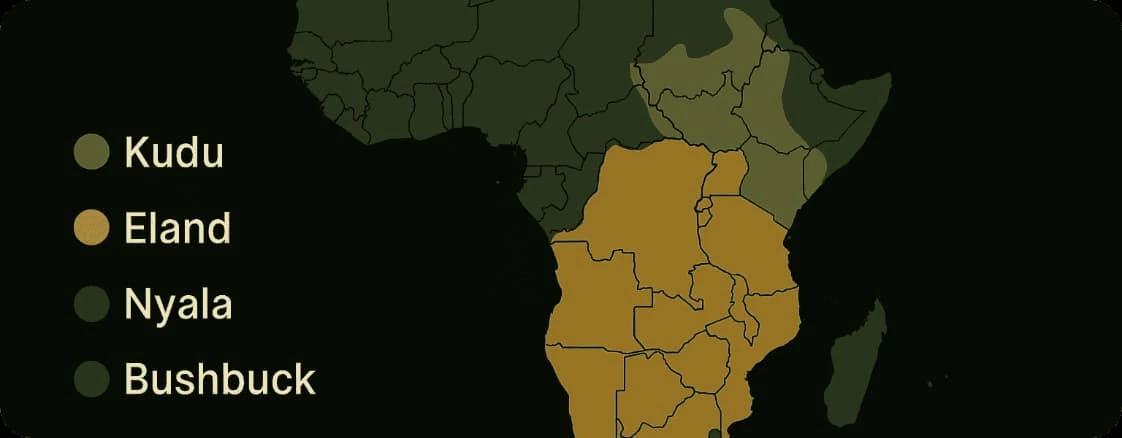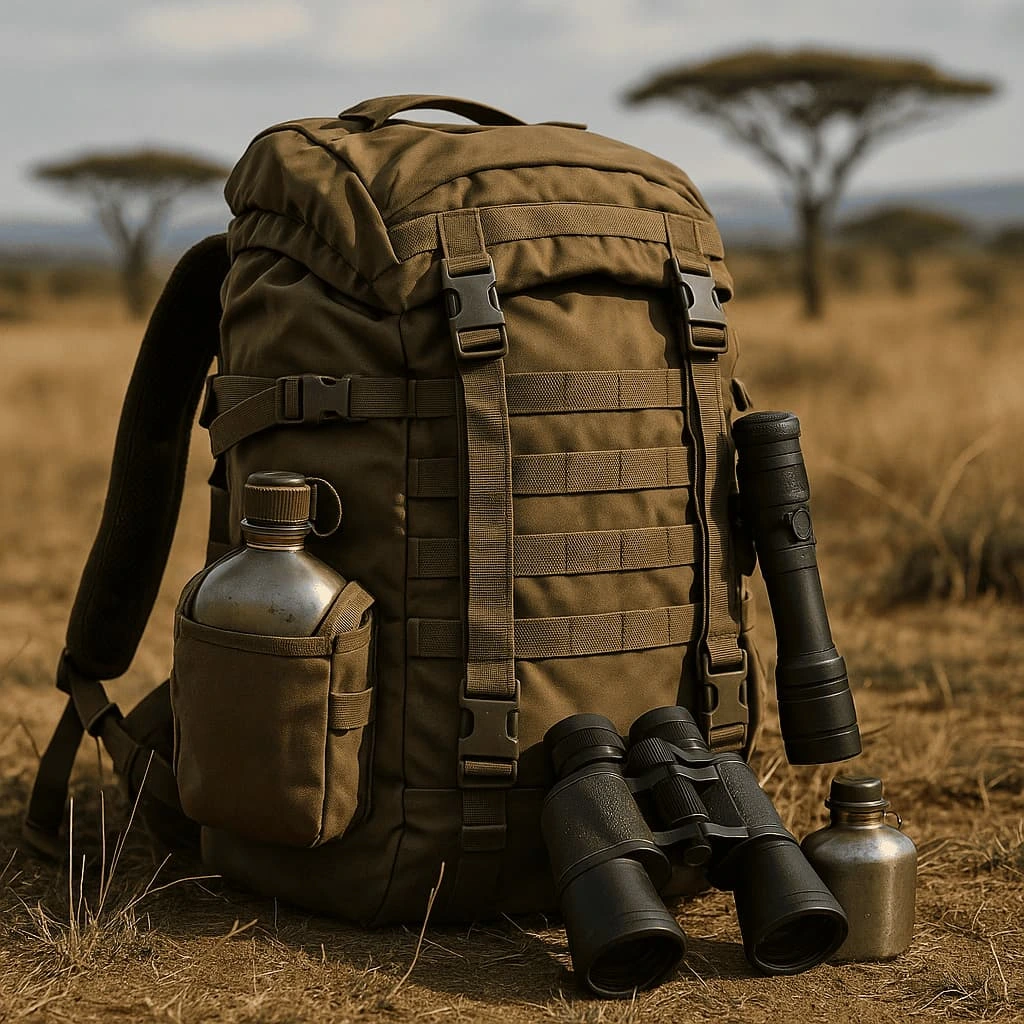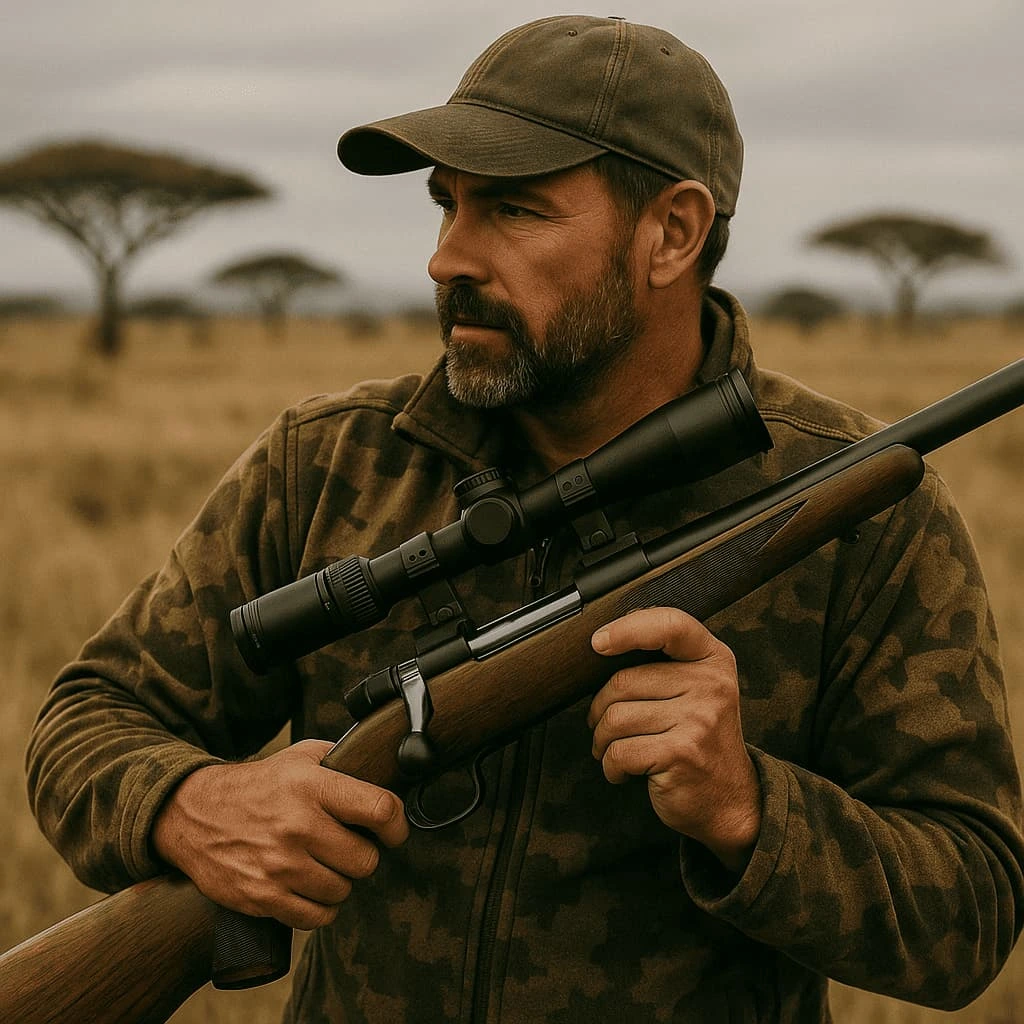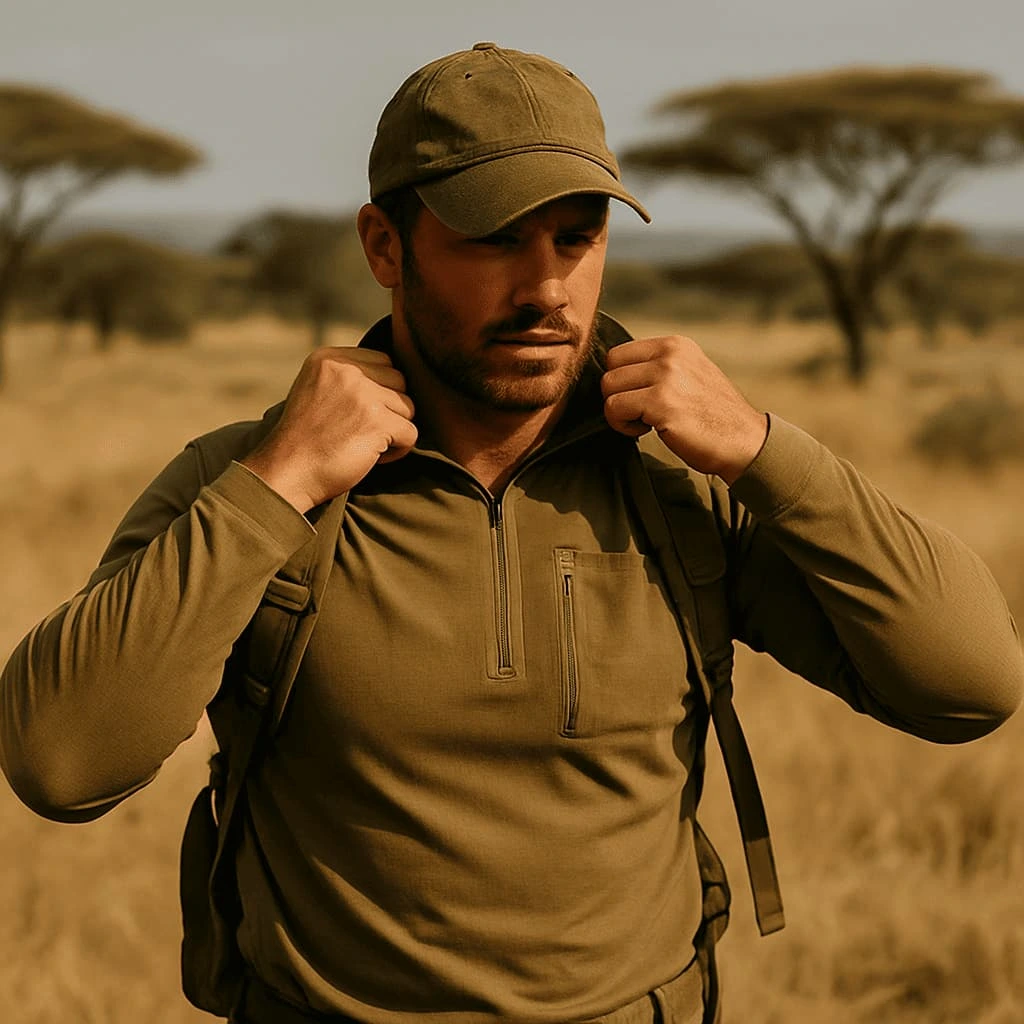
The African Spiral Horn Slam is one of the most iconic and biologically diverse achievements in big game hunting. This elite slam challenges hunters to ethically pursue a collection of Africa’s most elusive and beautifully adapted antelope species—each recognized for their characteristic spiral-horned trophies, wariness, and highly specific habitats. Unlike the African Big Five, which is defined by size and danger, this slam celebrates precision, patience, and an intimate understanding of regional ecosystems.
Completing the spiral horn slam requires hunters to travel across various biomes—dense rainforests, open savannahs, riverine woodlands, and mountainous terrain. With species ranging from the massive Lord Derby eland to the elusive forest-dwelling bongo and sitatunga, this journey is as much a test of adaptability and endurance as it is a tribute to African biodiversity.
With the SlamHunt App, hunters can now track their spiral horn species, log encounters, and connect with outfitters and other slam participants who share the same ambition.
Pursuing the African Spiral Horn Slam requires strategic planning across multiple ecological zones and countries. From East Africa’s acacia-dotted hillsides to the swampy lowlands of Central Africa, each region offers a distinct terrain, climate, and hunting approach. These hunts often involve coordination with specialized outfitters and guides familiar with local wildlife movement patterns, regulations, and logistical challenges.
Certain areas are only accessible seasonally, and others may require long-distance fly-ins, mobile camps, or tracking on foot for several days. Planning ahead to accommodate different elevations, vegetation types, and political regulations is crucial to safely and successfully harvesting all the species in this slam.

The African Spiral Horn Slam generally includes the following recognized species:
Greater Kudu: Found across Eastern and Southern Africa, this spiral-horned antelope thrives in woodland-savannah mosaics. Known for its towering spiral horns and elusive behavior, the greater kudu is often sought in fair chase hunts. Its ability to vanish into cover makes it a favorite in guided spiral horn expeditions.
Lesser Kudu: Native to dry bushlands of northeastern Africa, this elegant species demands precision and stealth. The lesser kudu’s rapid flight response and dense habitat make it one of the most challenging spiral horn species to hunt ethically.
Nyala: Inhabiting riverine woodlands and forest edges of South Africa and Mozambique, the nyala is prized for its distinct markings and timid nature. This trophy-class antelope prefers dense vegetation, rewarding hunters who value patience and strategic positioning.
Mountain Nyala: This rare highland antelope is endemic to the Bale Mountains of Ethiopia. It lives in steep alpine zones and demands multi-day backpack hunts. With extremely limited distribution and legal access, it’s one of the toughest spiral horn trophies to achieve.
Common Eland: As Africa’s largest antelope, the common eland roams open grasslands and light woodlands. Despite its bulk, it’s known for its speed and endurance. Long-range tracking and persistence are key to taking one in open terrain.
Lord Derby Eland: Also called the Giant Eland, this species inhabits remote hunting concessions in Central and Western Africa. Harvesting a mature bull requires logistical planning, local tracking expertise, and significant stamina.
Sitatunga: This swamp-dwelling, semi-aquatic antelope is one of the most difficult spiral horn species to hunt. Found near rivers and wetlands in equatorial Africa, sitatunga hunts often involve boats, blinds, and full waterproof gear.
Bongo: The bongo is a forest-dwelling antelope known for its reddish coat and nocturnal movement. It inhabits dense rainforests and is rarely seen during daylight. Hunting a bongo represents the pinnacle of fair chase spiral horn achievements.
Harnessed Bushbuck: With its wide sub-Saharan range, the bushbuck is often the first spiral horn species taken. It adapts to a variety of habitats and requires keen awareness due to its unpredictable behavior and strong territorial instincts
Successfully completing the African Spiral Horn Slam means facing a range of hunting conditions, from swamps to alpine zones. Some spiral-horned antelope are significantly more difficult to harvest due to habitat, legal access, and population scarcity. This section evaluates which species present the most demanding challenges:
Species | Terrain | Access | Population | Tag Availability | Overall Difficulty | Greater Kudu | Mixed woodland | Easy | Stable | Widely available | 🟡 Medium |
|---|---|---|---|---|---|
Lesser Kudu | Dense thicket | Limited | Low | Regionally restricted | 🟠 High |
Nyala | Forest edge | Moderate | Stable | Common | 🟡 Medium |
Mountain Nyala | High-altitude | Very Limited | Very Low | Extremely restricted | 🔴 Very High |
Commond Eland | Open savannah | Easy | Abundant | Available | 🟡 Medium |
Lord Derby Eland | Savannah woodland | Remote | Low | Restricted | 🟠 High |
Sitatunga | Swamps & wetlands | Very remote | Low | Rare | 🔴 Very High |
Bongo | Dense rainforest | Very Remote | Very Low | Highly restricted | 🔥 Extremely Hard |
Bushbuck | Varied | Easy | High | Common | 🟢 Easy |
There is no single universal body governing the African Spiral Horn Slam, but several internationally respected hunting organizations—such as Safari Club International (SCI) and Dallas Safari Club (DSC)—offer recognition for successfully harvesting all key spiral-horned species. To qualify, hunters must ethically harvest the required antelope species, providing documented evidence such as:
Most countries involved have strict hunting regulations and quota-based permits, often allocated through government lotteries, community conservancy programs, or licensed professional outfitters. Species like the mountain nyala or bongo require extensive planning due to limited accessibility and legal restrictions.
Pro tips:
– Start planning your trips by researching countries with sustainable spiral horn hunting programs.
– Work with outfitters who have verifiable experience with each species.
– Prepare a physical and digital log of all species—use the SlamHunt App to streamline documentation and progress tracking.
When pursuing the African Spiral Horn Slam, being properly equipped is essential for adapting to vastly different terrains—from mountain ridges to tropical wetlands. Each species and biome demands a tailored approach in clothing, gear, and weaponry. Here are three core equipment categories every slam participant should prepare:

Multi-day tracking in remote areas requires reliable support gear. Many hunts involve long distances on foot, wet terrain, and variable weather:
– 65–80L external-frame or hybrid backpack
– Hydration bladder and water purifier
– Knife with gut hook
– Flashlight or headlamp with red filter
– Compact binoculars or spotting scope
– First-aid kit and personal medications

Most hunts are conducted in dense brush or uneven terrain, where fast target acquisition is key:
– Bolt-action rifle chambered in .300 Win Mag, .375 Ruger, or .338 Win Mag
– Low-magnification variable scope (1.5–6x or 2–10x)
– Sling with quick-adjust strap system
– Soft case for mobility between camps
– Backup iron sights or red dot (for dense environments)

Due to the diversity of hunting environments—from dry highlands to wet, mosquito-infested forests—layered and adaptable clothing is vital:
– Moisture-wicking base layers
– Lightweight waterproof shell jacket
– Breathable mosquito-resistant shirts
– Insulated jacket for alpine areas
– Gaiters and thermal socks for marshes and high altitudes
Completing the African Spiral Horn Slam it’s a physically intense and logistically demanding challenge. From alpine zones in Ethiopia to flooded marshes in Central Africa, every expedition requires high levels of endurance, focus, and bushcraft.
Common physical and environmental challenges include:
• Multi-day treks in humid lowlands and high-altitude regions
• Long stalks through thorn bush, swamps, and mountainous terrain
• Sudden changes in temperature, from scorching heat to frigid mornings
• Dense vegetation limiting visibility and movement
• Navigating without roads, relying on local trackers and PH teams
Success in this slam demands advanced physical conditioning, familiarity with gear weight management, and psychological resilience to operate in high-risk, low-comfort environments.

Even experienced hunters make costly errors when pursuing this slam, due to its diversity of species, terrain, and legal complexities. Below are some of the most common pitfalls to avoid when aiming for the African Spiral Horn Slam:
Using platforms like SlamHunt allows you to plan ahead, avoid legal issues, and stay on track across the wide range of species and landscapes
Before embarking on your spiral horn journey, use this preparation checklist to cover all key logistics, legal, and gear considerations:
✔️ Confirm species distribution and habitat conditions
✔️ Apply for limited-entry or quota-based permits well in advance
✔️ Coordinate flights to remote concessions or hunting zones
✔️ Prepare field-ready gear kits adapted to each biome
✔️ Review national firearm laws and travel restrictions
✔️ Test optics, rangefinders, and rainproof equipment
✔️ Use the SlamHunt App to log hunts, track progress, and validate trophy data
✔️ Arrange CITES and border documentation for trophy export
The African Spiral Horn Slam is a premium-level hunting endeavor with costs that reflect the remoteness, rarity, and specialization of its species. Total investment varies depending on your outfitter selection, travel preferences, and gear requirements—but generally ranges between $90,000 and $200,000 USD.
Breakdown of potential expenses:
Outfitter fees (varies by species and country)
International travel, mobile camps, or fly-in safaris
CITES permits and trophy prep/export fees
Firearms and specialty gear for wetlands or alpine hunts
Tips, logistics, and tracker fees
While some hunters focus on one species per year, others combine hunts across borders to save on travel costs. Booking well in advance ensures access to prime concessions, experienced PHs, and better weather windows.
Locating the right outfitter is critical—especially for rare and difficult species like the bongo, mountain nyala, or Lord Derby eland. SlamHunt allows you to explore verified professionals with documented success in spiral horn antelope hunts
Seasonal timing is one of the most critical success factors in the African Spiral Horn Slam. Each species thrives in different ecosystems across Africa, and weather conditions can dramatically affect visibility, tracking, and safety. Here’s a general guide based on regional conditions and optimal rut or migration periods:
Greater Kudu & Nyala (South Africa, Mozambique): Best hunted from May to August
Bongo & Sitatunga (Central African Republic, Cameroon): Ideal window is the early dry season—January to March
Lesser Kudu & Eland (Tanzania, Ethiopia): Prime months are June to September
Mountain Nyala (Ethiopia): Typically hunted between October and December
Bushbuck: Available year-round but easiest to pursue during cooler, drier months for better tracking conditions.
Proper timing increases success, reduces cost overruns, and allows for ethical, stress-free trophy collection. Be sure to consult with local PHs or use the SlamHunt planning tool to align your expedition with ideal seasonal windows.
These hunters represent the level of planning, field experience, and species-specific knowledge required to successfully pursue the Slam:

Frank M.
Ireland
Tracking spiral-horned species across different ecosystems pushed me to improve every aspect of my planning

Franco T.
Michigan, USA
The SlamHunt app helped me document each step, from tagging a greater kudu in Namibia to logging details for a bongo in Cameroon
Most organizations that acknowledge the African Spiral Horn Slam require clear photographic evidence, including visible horns, hunter identity, date, and location. Additionally, confirmation by a licensed PH or outfitter is often expected, along with species identification. Optional elements like CITES documentation may be requested for restricted species.
You must verify that the concession or territory is legally registered for the species in question, with active quotas issued by the regional wildlife authority. A professional outfitter should provide copies of permits, quota status, and proof of legal operating status. This is especially important when hunting in areas with community conservancy models
Yes, some expeditions are structured to target 2–4 species within the same region, such as kudu, nyala, and bushbuck in Southern Africa. However, rarer species like bongo or mountain nyala usually require specialized trips. Combining species depends on geography, outfitter access, and seasonal overlaps in hunting regulations
Conservation Impact of the African Spiral Horn Slam
The African Spiral Horn Slam goes beyond the collection of rare trophies—it represents a deep engagement with some of Africa’s most complex wildlife systems. Hunters who take on this challenge often invest in long-term outfitter partnerships, regulatory compliance, and travel into remote habitats, indirectly supporting broader conservation infrastructure and local economies tied to ethical hunting
Participating in the African Spiral Horn Slam contributes more than just personal achievement—it plays an active role in funding and reinforcing sustainable wildlife programs across the continent. Many of the species in this slam inhabit sensitive ecosystems, and the revenue generated through tag fees, outfitter licensing, and trophy permits helps maintain those environments.
Funds from legal spiral horn hunts are often reinvested in:
• Anti-poaching patrols in remote concessions
• Population tracking for rare species like bongo and mountain nyala
• Habitat corridor preservation in transboundary areas
• Local training for wildlife monitors and conservation rangers
Because many spiral-horned antelope live in regions with limited infrastructure, hunting concessions become part of the conservation model—providing controlled human access, ongoing species data, and funding that would otherwise be unavailable
In countries like Cameroon, Ethiopia, Mozambique, and Namibia, spiral horn hunts often take place within community-managed reserves. These models ensure that local populations benefit directly from sustainable hunting, through employment, meat distribution, and revenue-sharing agreements.
The presence of hunters—under ethical and legal guidelines—also reduces illegal bushmeat poaching by establishing oversight, investing in local services, and creating economic incentives to protect game populations
Numerous regional and international organizations support spiral horn antelope conservation by:
• Funding scientific research and ecosystem studies
• Hosting tag raffles to raise conservation dollars
• Assisting in wildlife translocation efforts
• Educating communities on species protection
Hunters who pursue the Spiral Horn Slam become part of this ecosystem—where regulated hunting aligns with long-term biodiversity goals and ecological integrity.
Hunting app
Legal Policy